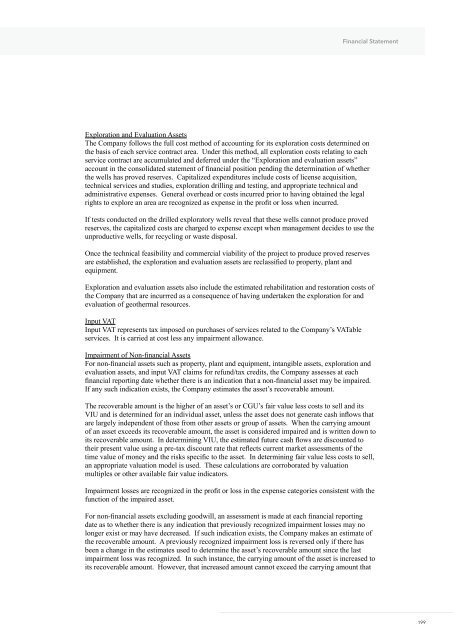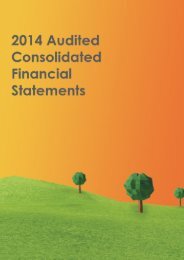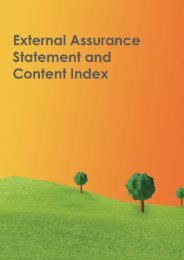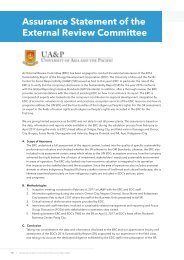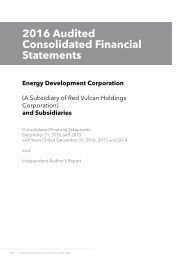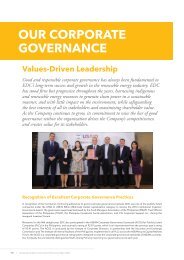EDC PR 2016
Create successful ePaper yourself
Turn your PDF publications into a flip-book with our unique Google optimized e-Paper software.
Financial Statement<br />
Exploration and Evaluation Assets<br />
The Company follows the full cost method of accounting for its exploration costs determined on<br />
the basis of each service contract area. Under this method, all exploration costs relating to each<br />
service contract are accumulated and deferred under the “Exploration and evaluation assets”<br />
account in the consolidated statement of financial position pending the determination of whether<br />
the wells has proved reserves. Capitalized expenditures include costs of license acquisition,<br />
technical services and studies, exploration drilling and testing, and appropriate technical and<br />
administrative expenses. General overhead or costs incurred prior to having obtained the legal<br />
rights to explore an area are recognized as expense in the profit or loss when incurred.<br />
If tests conducted on the drilled exploratory wells reveal that these wells cannot produce proved<br />
reserves, the capitalized costs are charged to expense except when management decides to use the<br />
unproductive wells, for recycling or waste disposal.<br />
Once the technical feasibility and commercial viability of the project to produce proved reserves<br />
are established, the exploration and evaluation assets are reclassified to property, plant and<br />
equipment.<br />
Exploration and evaluation assets also include the estimated rehabilitation and restoration costs of<br />
the Company that are incurrred as a consequence of having undertaken the exploration for and<br />
evaluation of geothermal resources.<br />
Input VAT<br />
Input VAT represents tax imposed on purchases of services related to the Company’s VATable<br />
services. It is carried at cost less any impairment allowance.<br />
Impairment of Non-financial Assets<br />
For non-financial assets such as property, plant and equipment, intangible assets, exploration and<br />
evaluation assets, and input VAT claims for refund/tax credits, the Company assesses at each<br />
financial reporting date whether there is an indication that a non-financial asset may be impaired.<br />
If any such indication exists, the Company estimates the asset’s recoverable amount.<br />
The recoverable amount is the higher of an asset’s or CGU’s fair value less costs to sell and its<br />
VIU and is determined for an individual asset, unless the asset does not generate cash inflows that<br />
are largely independent of those from other assets or group of assets. When the carrying amount<br />
of an asset exceeds its recoverable amount, the asset is considered impaired and is written down to<br />
its recoverable amount. In determining VIU, the estimated future cash flows are discounted to<br />
their present value using a pre-tax discount rate that reflects current market assessments of the<br />
time value of money and the risks specific to the asset. In determining fair value less costs to sell,<br />
an appropriate valuation model is used. These calculations are corroborated by valuation<br />
multiples or other available fair value indicators.<br />
Impairment losses are recognized in the profit or loss in the expense categories consistent with the<br />
function of the impaired asset.<br />
For non-financial assets excluding goodwill, an assessment is made at each financial reporting<br />
date as to whether there is any indication that previously recognized impairment losses may no<br />
longer exist or may have decreased. If such indication exists, the Company makes an estimate of<br />
the recoverable amount. A previously recognized impairment loss is reversed only if there has<br />
been a change in the estimates used to determine the asset’s recoverable amount since the last<br />
impairment loss was recognized. In such instance, the carrying amount of the asset is increased to<br />
its recoverable amount. However, that increased amount cannot exceed the carrying amount that<br />
199


